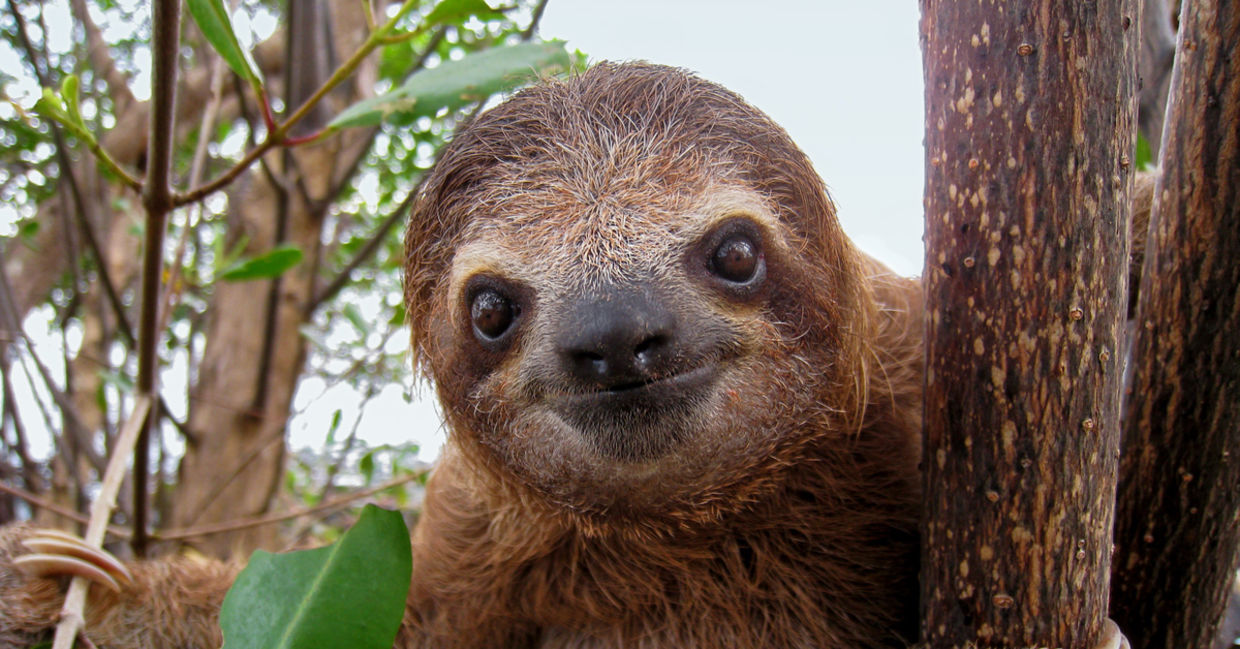
(Damsea / Shutterstock.com)
The growing fascination with sloths is everywhere these days. The adorable creatures living in the treetops of tropical forests in South and Central America, have not only become one of the most popular exotic pets, which might be controversial for some, but their endearing image is also present in countless forms of popular culture. These include toys, illustrations, cute viral videos and for the most daring, even in tattoos.
Their appeal goes far beyond their sweet looks and their laid back reputation. With sloths, there is much more than meets the eye. So let’s learn a bit about the real character of these fascinating animals, and you might discover some worthy life lessons.
Live a slow life
Sloths are the slowest mammals on the planet. Because of their extremely low metabolic rate, they move at a languid pace, traveling just 41 yards per day through the trees. This is equivalent to less than half the length of a soccer field, according to renowned nonprofit, the World Wildlife Fund
While most human beings are exhausted by the speed of modern life, running after things such as success, status or money, sloths spend their days eating and digesting leaves, and relaxing in the sun, as detailed on everwideningcircles.com
View this post on Instagram
So it is during these pandemic days, when many have started to question the status quo, that the slow lifestyle is gaining more and more advocates. The not-so-new slow perspective essentially offers an alternative to established values. One that is more connected to nature, mindfulness and the pursuit of serenity.
Sloths show us that slowing down is far from boring. Quite the opposite, it has been their key to survival in every possible way.
Be resilient
Sloths have been living on earth for more than 40 million years. So what's the secret to their endurance? This is what zoologist, Lucy Cooke, reveals in a compelling TED talk:
“There was a survey that was done in the 1970s in a Panamanian tropical forest that found that sloths were the most numerically abundant large animal. They took up one quarter of the mammalian biomass. Now, that's an awful lot of sloths and suggests they're doing something very right indeed”, Lucy Cook explains.
But how can an animal with poor hearing, bad eyesight, and one that can’t even run, survive its predators? Well, their movements are so slow, that it is extremely difficult for their predators to detect them. And their fur attracts significant moisture and so tends to be covered in algae that enables them to camouflage themselves among the trees.
In summary, qualities that seem weaknesses may well be the necessary strengths to withstand the difficulties ahead. Sloths show us it is just a matter of perception.
Be different
Being a sloth is being different in many senses. It is to go against the belief that celebrates skills and physical characteristics like speed, a large size, and ferociousness, as the only way to survive.
Sloths have a unique perspective, since they spend most of their lives literally upside down. Thanks to their long, hooked claws, they can do almost anything in an inverted position, from sleeping to eating to even giving birth.
View this post on Instagram
Their physiology is uniquely adapted so that their circulatory system pumps blood against gravity, as happens with their swallowing mechanism too. And equally surprisingly, their fur grows in the opposite direction that we’re used to; toward their back instead of their belly, so they can drip dry after the pouring rain that is common in their tropical ecosystem.
So sloths give us another great lesson: being different can have its advantages. In fact, it is what can make all the difference.
Be sustainable
What would you say if you had to survive on only 100 calories a day? It seems like an impossible challenge, one that sloths can achieve very successfully, however. They save energy for what’s truly important like feeding on leaves. And since they digest food more slowly than any other mammals, they have more than enough time to process all the toxins present in their food, reducing waste to the minimum. Believe it or not, they come down from the trees to relieve themselves just once a week.
So, according to everwideningcircles.com, sloths also teach us to be sustainable by reducing the waste that they generate and by saving energy only for those things that really matter in life.
Now you know why you should be slowing down, just like sloths. They deserve to be acknowledged as cult animals less because of their cute looks and instead, mainly due to their unique and unconventional capacity for adaptation as well as their philosophy on life. The expression “hang in there” couldn’t be more appropriate to describe these adorable and resilient furry creatures.







